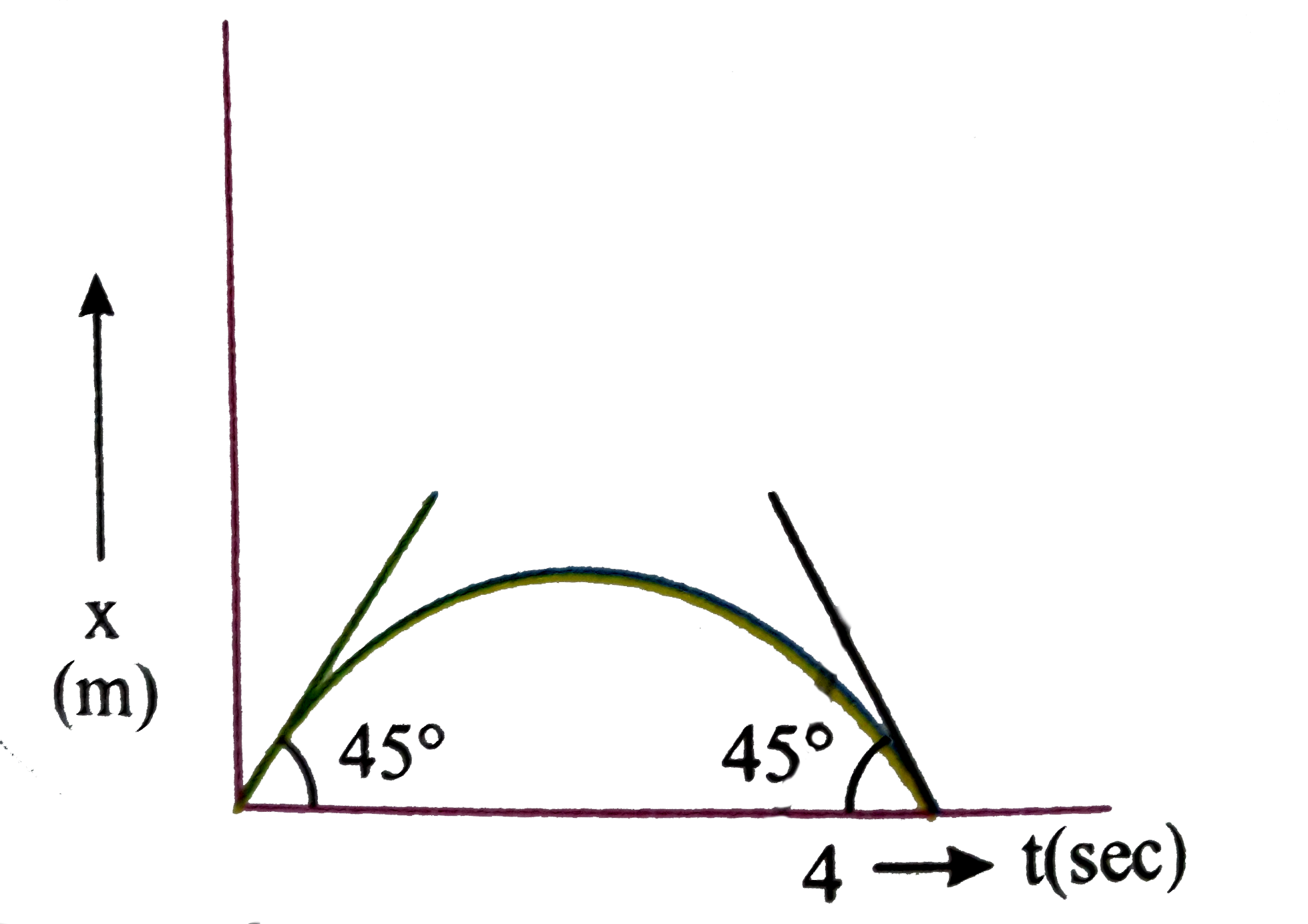A particle is moving along -axis with constant acceleration. At , the particle is at and . The maximum value of co-ordiante of the particle is observed 2 seconds later. Starting from sec, after what time, particle reaches its initial position again?
The correct Answer is:A
To solve the problem step by step, we will analyze the motion of the particle under constant acceleration.
Step 1: Understand the Initial Conditions
At time t=0:
- The position of the particle is x0=3m.
- The initial velocity is v0=dxdt=4m/s.
Step 2: Determine the Acceleration
The problem states that the maximum value of the x-coordinate is observed 2 seconds later. This indicates that the particle comes to rest at this maximum position. We can use the equation of motion:
v=u+at
At t=2s, the final velocity v=0:
0=4+a(2)
From this, we can solve for acceleration a:
a=−42=−2m/s2
Step 3: Calculate the Maximum Position
Now, we can calculate the maximum position xmax using the equation of motion:
s=ut+12at2
Substituting u=4m/s, a=−2m/s2, and t=2s:
s=4(2)+12(−2)(22)
Calculating this gives:
s=8−4=4m
Thus, the maximum position xmax is:
xmax=x0+s=3+4=7m
Step 4: Determine the Time to Return to Initial Position
The particle will return to its initial position after reaching the maximum position. The time taken to return to the initial position can be calculated by finding the time taken to travel back from xmax=7m to x0=3m.
Using the same equation of motion:
s=ut+12at2
Here, the initial velocity u=0 (at the maximum position) and the distance s=−4m (since it is returning to the left):
−4=0+12(−2)t2
This simplifies to:
−4=−t2⇒t2=4⇒t=2s
Step 5: Total Time Calculation
The total time taken to return to the initial position:
ttotal=ttomax+ttoinitial=2+2=4s
Final Answer
The particle reaches its initial position again after 4s.
---
At time t=0:
- The position of the particle is x0=3m.
- The initial velocity is v0=dxdt=4m/s.
The problem states that the maximum value of the x-coordinate is observed 2 seconds later. This indicates that the particle comes to rest at this maximum position. We can use the equation of motion:
v=u+at
At t=2s, the final velocity v=0:
0=4+a(2)
From this, we can solve for acceleration a:
a=−42=−2m/s2
Now, we can calculate the maximum position xmax using the equation of motion:
s=ut+12at2
Substituting u=4m/s, a=−2m/s2, and t=2s:
s=4(2)+12(−2)(22)
Calculating this gives:
s=8−4=4m
Thus, the maximum position xmax is:
xmax=x0+s=3+4=7m
The particle will return to its initial position after reaching the maximum position. The time taken to return to the initial position can be calculated by finding the time taken to travel back from xmax=7m to x0=3m.
s=ut+12at2
Here, the initial velocity u=0 (at the maximum position) and the distance s=−4m (since it is returning to the left):
−4=0+12(−2)t2
This simplifies to:
−4=−t2⇒t2=4⇒t=2s
The total time taken to return to the initial position:
ttotal=ttomax+ttoinitial=2+2=4s
The particle reaches its initial position again after 4s.
Topper's Solved these Questions
- BOOK - DC PANDEYCHAPTER - KINEMATICS 1EXERCISE - MCQ_TYPE27videos
KINEMATICS 1
- BOOK - DC PANDEYCHAPTER - KINEMATICS 1EXERCISE - COMPREHENSION_TYPE19videos
KINEMATICS 1
- BOOK - DC PANDEYCHAPTER - KINEMATICSEXERCISE - INTEGER_TYPE11videos
KINEMATICS
- BOOK - DC PANDEYCHAPTER - LAWS OF MOTIONEXERCISE - Medical entrances gallery39videos
LAWS OF MOTION
Similar Questions
Position of particle moving along x-axis is given by x=2t^(3)-4t+3 Initial position of the particle is
View SolutionA particle confined to motion along an x axis moves with constant acceleration from x=2.0m to x=8.0 m during a 2.5 s time interval. The velocity of the particle at x=8.0m is 2.8 m/s. What is the constant acceleration during this time interval ?
View Solution
Knowledge Check
- Question 1 - Select One
A particle is moving along the x-axis whose acceleration is given by a=3x−4, where x is the location of the particle. At t = 0, the particle is at rest at x=4/3m. The distance travelled by the particles in 5 s is
AzeroB42 mCInfiniteDNone of these - Question 2 - Select One
A particle is moving along the x-axis with an acceleration a = 2x where a is in ms–2andx is in metre. If the particle starts from rest at x=1 m, find its velocity when it reaches the position x = 3.
A8 m/sB16 m/sC4 m/sD0 m/s - Question 3 - Select One
The velocity of a particle moving with constant acceleration at an instant t0 is 10m/s After 5 seconds of that instant the velocity of the particle is 20m/s. The velocity at 3 second before t0 is:-
A12B1C2D4
A particle is moving along x-direction with a constant acceleration a. The particle starts from x=x0 position with initial velocity u. We can define the position of the particle with time by the relation
x=x0+ut+12at2
plot the position of the particle in relation with time is following situations
(i) If initial position of the particle is on negativ x-axis, initial velocity is positive and acceleration is negative.
(ii) If initial position is positive, initial velocity is negative and acceleration is positive.View SolutionA particle is moving with uniform acceleration. Its position (x) is given in term of time (t in sec) as x= '(5t^2 +4t +8)' m, then
View SolutionA particle is moving with initial velocity 1m/s and acceleration a=(4t+3)ms2. Find velocity of particle at t=2sec.
View SolutionA particle starts from rest and moves with an acceleration of a={2+|t−2|}m/s2 The velocity of the particle at t=4 sec is
View SolutionA particle moves along x-axis with constant acceleration and its x-position depend on time t as shown in the following graph (parabola),then in interval 0 to 4sec.
 View Solution
View Solution

